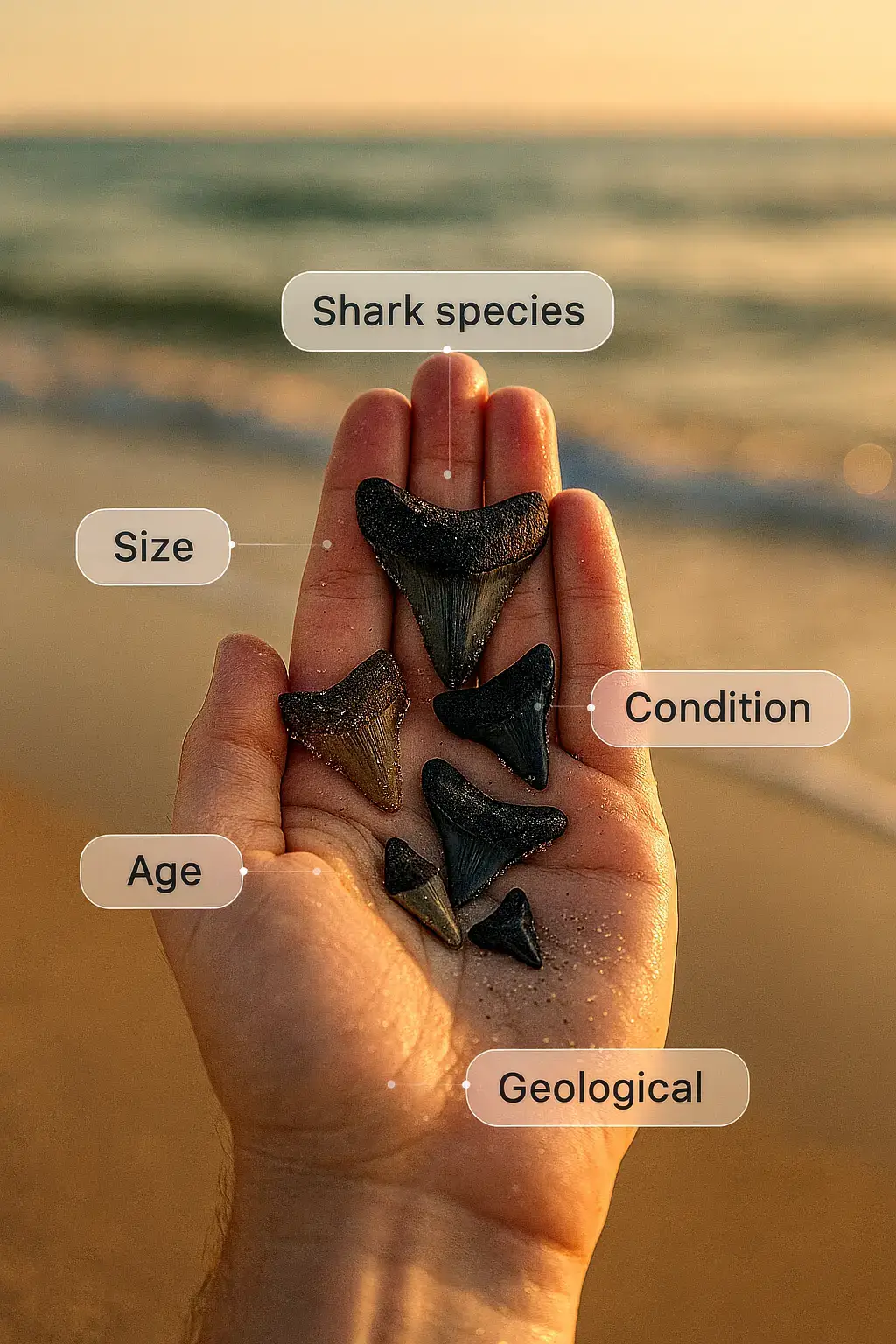How to Identify Megalodon Teeth: Expert Guide
Master the art of identifying authentic Megalodon teeth with our step-by-step expert guide. Learn size requirements, serration patterns, and authenticity verification techniques used by professional paleontologists.

Step 1: Check the Size - Megalodon Teeth Are Large
The first step in how to identify Megalodon teeth is examining the size. Authentic Megalodon teeth are significantly larger than modern shark teeth, ranging from 3 to over 7 inches in length.
Minimum Size Requirements
Genuine Megalodon teeth start at approximately 3 inches (7.6 cm) in length. Anything smaller is likely from a juvenile Megalodon or a completely different species. Most collectors focus on teeth 4+ inches for verified authenticity.
Size Categories
- 3-4 inches: Juvenile Megalodon (20-30 feet shark length)
- 4-5 inches: Sub-adult Megalodon (30-45 feet shark length)
- 5-6 inches: Adult Megalodon (45-55 feet shark length)
- 6+ inches: Exceptional specimens (55+ feet shark length)

Step 2: Examine Shape and Serration Patterns
Learning how to identify Megalodon teeth requires understanding their distinctive triangular shape and fine serration patterns that separate them from modern shark teeth.
Triangular Shape
Authentic Megalodon teeth have a broad, robust triangular shape. The crown is wider at the base and tapers to a sharp point. The overall proportions are more substantial than modern Great White teeth.
Fine Serrations
Megalodon teeth feature extremely fine, sharp serrations along both cutting edges. These serrations are typically finer and more numerous than those found on modern shark teeth, designed for slicing through large marine mammals.
Root Structure
The root system is thick and V-shaped when viewed from the side, with visible nutrient grooves. Authentic specimens show natural wear and attachment points where the tooth connected to the jaw cartilage.

Step 3: Verify Authenticity - Real vs Fake Megalodon Teeth
The final step in how to identify Megalodon teeth involves authenticity verification. With high market values, many replicas and fakes exist in the fossil trade.
Fossilization Indicators
Real Megalodon teeth are fossilized, making them heavy and typically dark brown, black, or gray in color. The fossilization process replaces original organic material with minerals over millions of years.
Weight Test
Authentic fossilized teeth feel substantially heavier than modern teeth or replicas. The mineralization process increases density significantly. If it feels too light for its size, be suspicious.
Common Fake Indicators
- Perfect condition with no natural wear or damage
- Uniform coloration without natural variation
- Machine-made serrations that appear too regular
- Lightweight feel despite large size
- Prices that seem too good to be true
Use Technology
Our free shark tooth identifier app can help verify Megalodon teeth using AI analysis of size proportions, serration patterns, and other morphological features.

Related Features
Explore more shark tooth identification features
Real vs Fake Shark Teeth
Complete authentication guide for verifying genuine shark teeth and avoiding costly fakes in the collector market.
Learn MoreBest Shark Tooth Identification App
Discover the top-rated AI-powered app for instant Megalodon tooth verification and species identification.
Learn MoreFrequently Asked Questions
Common questions about this feature
How big do Megalodon teeth need to be to be authentic?
Authentic Megalodon teeth start at approximately 3 inches (7.6 cm) in length. Most genuine specimens range from 4-6 inches, with exceptional finds reaching over 7 inches. Anything under 3 inches is likely from a different species.
What color should real Megalodon teeth be?
Real Megalodon teeth are fossilized and typically appear dark brown, black, gray, or sometimes blue-gray. The color comes from minerals absorbed during fossilization over millions of years. Bright white teeth are usually modern shark teeth, not Megalodons.
How can I tell if a Megalodon tooth is fake?
Fake Megalodon teeth often feel too light, have perfect condition with no wear, show uniform coloration, or have machine-made serrations. Real fossils have natural imperfections, proper weight from mineralization, and varying color patterns.
Where are Megalodon teeth commonly found?
Megalodon teeth are found worldwide in areas that were once ancient ocean floors. Popular locations include the southeastern United States (Florida, North Carolina, South Carolina), California, Chile, Australia, and parts of Europe.
How old are Megalodon teeth fossils?
Megalodon lived approximately 23 to 3.6 million years ago during the Miocene and Pliocene epochs. Most commonly found teeth are from the Miocene period (23-5 million years ago) when these massive sharks were most abundant.
Can an app really identify Megalodon teeth accurately?
Yes, modern AI-powered apps can analyze size ratios, serration patterns, and morphological features to help verify Megalodon teeth. Our app uses machine learning trained on thousands of verified specimens to provide reliable identification assistance.
Ready to Identify Shark Teeth?
Download the Shark Tooth Identifier App and start identifying shark teeth with AI-powered precision.
Download Free App